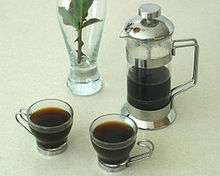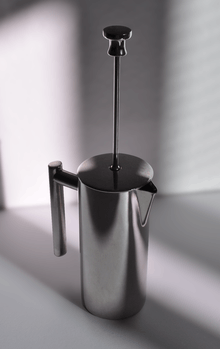French press
A French press, also known as a cafetière, cafetière à piston, caffettiera a stantuffo, press pot, coffee press, or coffee plunger, is a coffee brewing device, although it can also be used for other tasks. Two French inventors (Mayer and Delforge) patented in 1852 a forerunner of the French press. A patent was filed by a Frenchman, Marcel-Pierre Paquet dit Jolbert, officially published on August 5, 1924. In 1923 Ugo Paolini, an Italian, lodged patent documents relating to a tomato juice separator and he developed the idea of making a coffee pot with a press action and a filter. He assigned his 1928 patent to Italian designer Attilio Calimani and Giulio Moneta[1] who filed it in 1929.[2]

Nomenclature
In English, the device is known in North America as a French press or coffee press; in Britain and Ireland as a cafetière; in New Zealand, Australia, and South Africa, as a coffee plunger, and coffee brewed in it as plunger coffee. In Italian it is known as a caffettiera a stantuffo; in German, as a Stempelkanne (“stamp pot”); in French as cafetière à piston, or simply as cafetière (also the usage in Dutch), though some speakers might also use genericized trademarks, such as Melior or Bodum.
History and design

Over the years, the French press has undergone several design modifications. The first coffee press, which may have been made in France, was the modern coffee press in its rudimentary form—a metal or cheesecloth screen fitted to a rod that users would press into a pot of hot water and coffee grounds. The coffee press was patented by Milanese designer Attilio Calimani in 1929. It underwent several design modifications through Faliero Bondanini, who patented his own version in 1958 and began manufacturing it in a French clarinet factory called Martin SA under the brand name "Melior".[3] Its popularity may have been aided in 1965 by its use in the Michael Caine film The Ipcress File. The device was further popularized across Europe by a British company by the name of Household Articles Ltd. and the Danish tableware and kitchenware company Bodum.
The modern French press consists of a narrow cylindrical beaker, usually made of glass or clear plastic, equipped with a metal or plastic lid and plunger that fits tightly in the cylinder and has a fine stainless steel wire or nylon mesh filter.
Operation
Coffee is brewed by placing coarsely ground coffee in the empty beaker and adding hot—between 93–96 °C (199–205 °F)—water, in proportions of about 30 g (1.1 oz) of coffee grounds to 500 ml (17 US fl oz) of water, more or less to taste. The brewing time is about two to four minutes. Then the mesh plunger or piston is pressed, to separate the grounds and hold them at the bottom of the beaker. The mesh piston normally does not compress the coffee grounds, as most designs leave a generous space—about 30 mm (1.2 in)—below the piston in its lowest position. If the brewed coffee is allowed to remain in the beaker with the used grounds, the coffee may become astringent and bitter, though this is an effect that some users of the French press consider desirable.
A French press works best with coffee of a coarser grind than does a drip brew coffee filter, about the consistency of kosher salt.[4] Finer coffee grounds, when immersed in water, have lower permeability, requiring an excessive amount of force to be applied by hand to lower the plunger and are more likely to seep through or around the perimeter of the press filter and into the coffee drink.[5] Additionally, finer grounds will tend to over-extract and cause the coffee to taste bitter.[4]
It is believed that the optimum time for brewing the coffee is around four minutes.[6] Other approaches, such as cold brewing, require several hours of contact between the water and the grounds to achieve the desired extraction.
Variations
French presses are more portable and self-contained than other coffee makers. Travel mug versions exist, which are made of tough plastic instead of the more common glass, and have a sealed lid with a closable drinking hole. Some versions are marketed to hikers and backpackers not wishing to carry a heavy, metal percolator or a filter using drip brew. Other versions include stainless steel, insulated presses designed to keep the coffee hot, similar in design to thermos flasks. One variation uses a "pull" design: the coffee grounds are placed in a mesh basket, which is then pulled into the lid after brewing, trapping the grounds out of the coffee. Others produce a similar effect by having shutters that can be closed via the top of the press, sealing the grounds off from the coffee entirely. French presses are also sometimes used to make cold brew coffee.
Tea
In the same way as coffee, a French press can also be used in place of a tea infuser to brew loose tea. To some extent the tea will continue to steep even after the plunger is depressed, which may cause the tea remaining in the press to become bitter. It might thus be advisable to decant the tea into a serving vessel after preparation. The same French press should not be used for both tea and coffee unless thoroughly cleaned, as coffee residue may spoil the flavor of the tea.
However, this method is more suitable for light teas and is not suitable for Indian Chai (which requires to be boiled) or Chinese tea (which tends to be diffused for a long time, with tea leaves reused as a rule).[7]
Broth straining
A French press can also be used for straining broth from shellfish or other ingredients.[8]
References
- U.S. Patent 1,797,672A
- James Hoffmann (17 November 2014). The World Atlas of Coffee : From beans to brewing : coffees explored, explained and enjoyed. Octopus. p. 76. ISBN 978-1-84533-863-3.
- Melior Line, "The Melior Way of Brewing Coffee and Tea" http://www.melior-line.com/files/melior_brochure_2009.pdf Archived 2016-12-02 at the Wayback Machine
- Brew Perfect French Press Coffee with this Recipe - Crema.co, retrieved 2017-04-10
- Millman, China (2009-04-23). "Freshen Up; Manual Brewing Techniques Give Coffee Lovers a Better Way to Make a Quality Drink". Pittsburgh Post-Gazette. Retrieved 2009-06-16.
- Rinsky, Laura Halpin (2008). The Pastry Chef's Companion. John Wiley & Sons. p. 119. ISBN 978-0-470-00955-0.
- Tong, Liu (1 June 2010). Chinese tea - the definitive guide (2nd ed.). Beijing: China Intercontinental Press. ISBN 978-7508516677.
- Bilow, Rochelle (May 9, 2015). "Why You Should Be Making Broth in Your French Press". Bon Appétit. Retrieved May 29, 2019.
External links
| Wikimedia Commons has media related to |

